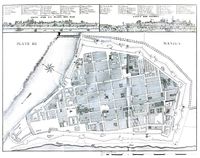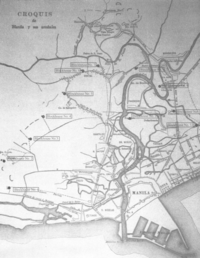معركة مانيلا (1899)
| Battle of Manila | |||||||
|---|---|---|---|---|---|---|---|
| جزء من the Philippine–American War | |||||||
 U.S. soldiers of the First Nebraska volunteers, company B, near Manila in 1899. | |||||||
| |||||||
| المتحاربون | |||||||
|
|
| ||||||
| القادة والزعماء | |||||||
|
|
| ||||||
| القوى | |||||||
|
8,000 in Manila 11,000 outer defenses[1] |
| ||||||
| الضحايا والخسائر | |||||||
|
55 killed 204 wounded[2] |
238 killed 306 captured[2] | ||||||
The Battle of Manila (Filipino: Labanan sa Maynila; إسپانية: Batalla de Manila), the first and largest battle of the Philippine–American War, was fought on February 4–5, 1899, between 19,000 American soldiers and 15,000 Filipino armed militiamen. Armed conflict broke out when American troops, under orders to turn away insurgents from their encampment, fired upon an encroaching group of Filipinos. Philippine President Emilio Aguinaldo attempted to broker a ceasefire, but American General Elwell Stephen Otis rejected it and fighting escalated the next day. It ended in an American victory, although minor skirmishes continued for several days afterward.
. . . . . . . . . . . . . . . . . . . . . . . . . . . . . . . . . . . . . . . . . . . . . . . . . . . . . . . . . . . . . . . . . . . . . . . . . . . . . . . . . . . . . . . . . . . . . . . . . . . . . . . . . . . . . . . . . . . . . . . . . . . . . . . . . . . . . . . . . . . . . . . . . . . . . . . . . . . . . . . . . . . . . . . .
Disposition of forces
Filipino forces
After the surrender of Manila to American forces by the Spanish in 1898, General Aguinaldo demanded occupation of a line of blockhouses on the Zapote Line, which had been the Spanish defensive perimeter. General Otis initially refused this, but later said that he would not object unless overruled by higher authority.[3] It was estimated at the time that there were about 20,000 Filipino troops surrounding Manila, with their distribution and exact composition only partially known.[4]
American forces
U.S. Army forces numbered some 800 officers and 20,000 enlisted men. Of these, some 8,000 were deployed in Manila and 11,000 in a defensive line inside the Zapote line. The remaining American troops were in Cavite or in transports off Iloilo.[1]
First shots
Sources generally agree that the first shots were fired by Private William Walter Grayson, an Englishman who had migrated to America c. 1890, had enlisted as a volunteer soldier in Lincoln, Nebraska, in May 1898, a month after the Spanish–American War erupted, and had deployed with his unit to the Philippines in June 1898.[5] Grayson's unit, the First Nebraska Volunteer Infantry under Colonel John M. Stotsenburg, had been encamped in Santa Mesa, Manila, since December 5, 1898.[6] During the time of their encampment, there had been incidents on and around the San Juan Bridge, located just to the east of their encampment area.[7]
Reactions of Aguinaldo and Otis
Aguinaldo was away in Malolos when the conflict started on the 4th. That same night, a Filipino captain in Manila wired him in Malolos, stating that the Americans had started the hostilities. Aguinaldo wanted to avoid open conflict with the Americans while maintaining his position of leadership with his nationalist followers. The next day (February 5) Aguinaldo sent an emissary to General Otis to mediate, saying "the firing on our side the night before had been against my order."[8]
See also
References
- ^ أ ب ت Linn 2000, p. 42.
- ^ أ ب خطأ استشهاد: وسم
<ref>غير صحيح؛ لا نص تم توفيره للمراجع المسماةlinn2000p52 - ^ Legarda 2001, pp. 10–12.
- ^ Legarda 2001, p. 15.
- ^ Medina & Medina 2002, p. 30.
- ^ Legarda 2001, pp. 22–24.
- ^ Legarda 2001, pp. 37–39, Agoncillo 1990, p. 217.
- ^ Agoncillo 1990, p. 218.
Bibliography
- Agoncillo, Teodoro (1990) [1960], History of the Filipino People (Eighth ed.), R.P. Garcia Publishing Company, ISBN 971-10-2415-2
- Constantino, Renato (1975), The Philippines: A Past Revisited, Tala Pub. Services, https://books.google.com/books?id=Q1ZxAAAAMAAJ
- Feuer, A. B. (2002), America at War: the Philippines, 1898–1913, Greenwood Publishing Group, ISBN 0-275-96821-9, https://books.google.com/books?id=pg-SZanwnuIC
- Legarda, Benito Justo (2001), The Hills of Sampaloc: The Opening Actions of the Philippine–American War, February 4–5, 1899, Bookmark, ISBN 978-971-569-418-6, https://books.google.com/books?id=9fhwAAAAMAAJ
- Linn, Brian McAllister (2000), The Philippine War, 1899–1902, University Press of Kansas, ISBN 978-0-7006-1225-3, https://books.google.com/books?id=PSJGPgAACAAJ
- Medina, Isagani R.; Medina, Mirana R. (2002), "The First Shot That Triggered the Filipino-American War on the 4th of February 1899 Did Not Happen At San Juan Bridge", Espionage in the Philippines, 1896–1902, and other essays, UST Pub. House, pp. 29–48, ISBN 978-971-506-184-1, https://books.google.com/books?id=7V9xAAAAMAAJ
- Miller, Stuart Creighton (1982), Benevolent Assimilation: The American Conquest of the Philippines, 1899–1903, Yale University Press, ISBN 0-300-02697-8, https://books.google.com/books?id=Zj6g2ag47TwC
. . . . . . . . . . . . . . . . . . . . . . . . . . . . . . . . . . . . . . . . . . . . . . . . . . . . . . . . . . . . . . . . . . . . . . . . . . . . . . . . . . . . . . . . . . . . . . . . . . . . . . . . . . . . . . . . . . . . . . . . . . . . . . . . . . . . . . . . . . . . . . . . . . . . . . . . . . . . . . . . . . . . . . . .
للاستزادة
- Aguinaldo, Emilio (سبتمبر 23, 1899). "Chapter XIX. Outbreak of Hostilities". True Version of the Philippine Revolution.
{{cite book}}: Unknown parameter|dead-url=ignored (|url-status=suggested) (help) - Silbey, David J. (فبراير 4, 2013). "February 4, 1899: The Start of the Philippine-American War and Patron-Client Fighting". Command Posts. Archived from the original on مارس 16, 2013.
{{cite web}}: Unknown parameter|dead-url=ignored (|url-status=suggested) (help)
- Use mdy dates from January 2012
- Articles containing إسپانية-language text
- Pages using Lang-xx templates
- CS1 errors: unsupported parameter
- CS1: Julian–Gregorian uncertainty
- Philippines articles missing geocoordinate data
- All articles needing coordinates
- Conflicts in 1899
- 1899 in the Philippines
- Battles of the Philippine–American War
- History of Manila
- February 1899 events




